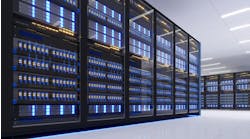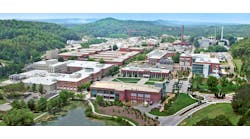Iron Mountain is building a 7.2-megawatt solar energy array on the roof of its massive data center building in Edison, New Jersey, the company said this week. The project will be the largest rooftop solar deployment in the history of the data center industry.
The announcement reinforces Iron Mountain’s commitment to renewable energy and sustainability, which is driven by the company’s large base of enterprise customers, many of whom are sharpening their focus on the environmental footprint of their IT infrastructure. It also highlights the somewhat surprising role of New Jersey as the site of some of the data center industry’s largest on-site solar arrays.
The new solar array will be built atop Iron Mountain New Jersey, an 830,000 square foot building just off the New Jersey Turnpike in Edison, about 30 miles South of Manhattan. The building was a printing plant for the New York Times until 2011, when IO bought the building and retrofitted it to house modular data centers. Iron Mountain acquired IO in 2017.
The Edison solar installation is being developed in collaboration with NextEra Energy Resources, and Black Bear Energy, and is slated for completion at the end of 2019. Iron Mountain will purchase electricity from the operators through a power purchase agreement (PPA). The array is forecast to generate more than 9 million kilowatt hours (kWh) per year, or approximately 15 percent of the data center’s current energy load.
Positive Planetary Impact
“This is a great example of data center industry leaders working together to use their market influence and purchasing power in ways that encourage cost effective, renewable energy options for everyone,” said Kevin Hagen, Vice President Environment, Social & Governance (ESG) Strategy at Iron Mountain. “Renewable energy can now be delivered at or below grid costs and often with the added benefit of long-term stable pricing, making solar and wind not only the more sustainable option, but also the more economically attractive choice.”
“Iron Mountain is a model of how solar energy can help companies achieve their sustainability goals while creating significant savings,” said Matt Ulman, executive director of distributed generation for NextEra Energy Resources. “This landmark project is fully developed and in construction, and we’re looking forward to seeing it commissioned and operating.”
“This project has positive planetary and financial impact and will continue to deliver for two decades to come,” said Drew Torbin, CEO, Black Bear Energy.
As it has expanded its data center footprint, Iron Mountain has arranged PPAs of renewable energy to offset the use of electricity in its data centers.
“The on-site solar PPA will be added to a portfolio of renewable energy contracts that already cover 100 percent of Iron Mountain’s worldwide data center operations,” said Hagen. “It’s part of Iron Mountain’s mission to obtain local, reliable, cost effective, 24/7 renewable energy solutions to meet the company’s RE100 goal of 100 percent renewable electricity for global operations.”
Improving Access to Solar
Iron Mountain recently became the first provider to implement a new reporting protocol that makes it easier for companies to apply green energy credits from their use of third-party colocation space to their corporate sustainability goals.
One of the participants in that program is Akamai Technologies, a leading provider of content delivery services, which is also a customer in Edison.
“Akamai has developed a state-of-the-art, energy-efficient data center to support our New York tri-state platform operations,” said Mike Mattera, director, corporate sustainability at Akamai. “Iron Mountain’s Green Power Pass was a valuable part of that deployment. With Iron Mountain’s rooftop solar installation, the partnership now aides our renewable strategy on a more local level.”
An aerial view of the QTS Data Centers facility in Piscataway, New Jersey. (Photo: DuPont Fabros)
The project arrives as a series of weather-driven disasters is boosting the urgency for the corporate sector to address climate change risk by slashing dependence upon fossil fuels. The rapid growth of cloud computing has sharpened the focus on the data center sector’s role in retooling the economy for a sustainable future.
On-site solar power is a recent development in data centers, partly because a very large installation of photovoltaic solar panels is required to produce even a fraction of the energy required by most data centers. The industry has come a long way since 2005, when AISO built the first fully solar-powered data center, using 120 photovoltaic panels to provide all the power for a 2,000-square-foot data hall.
The huge rooftop of Iron Mountain New Jersey offers an opportunity to create a much more substantial solar generation capacity.
New Jersey is already home to several of the largest solar arrays in the data center industry. The QTS Princeton data center in New Jersey taps an adjacent solar field featuring 57,000 solar panels that generate up to 14.1 megawatts of power. QTS also has a 2-megawatt solar array on the rooftop of its facility in Piscataway, which was acquired from DuPont Fabros.
There’s more solar on the way. Colocation specialist Switch has announced plans to help create a 1 gigawatt solar energy project in Nevada, which will be the largest solar array in the United States.







